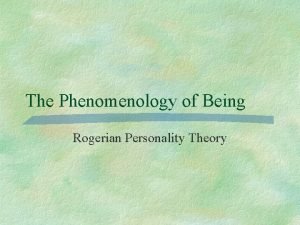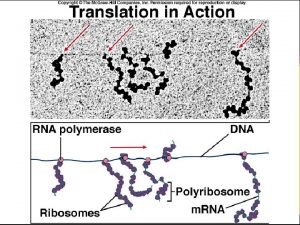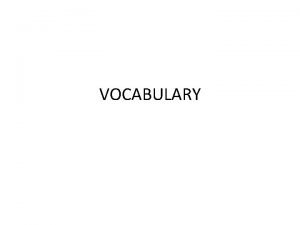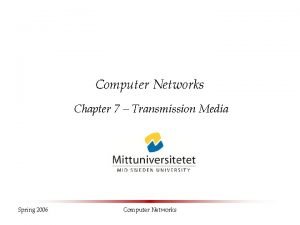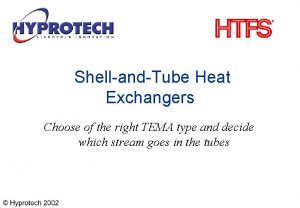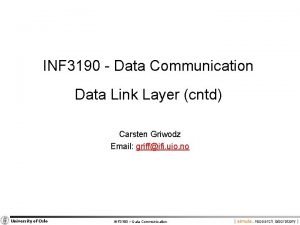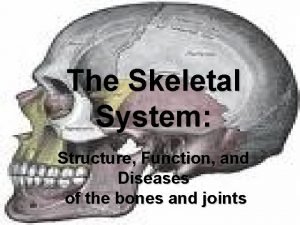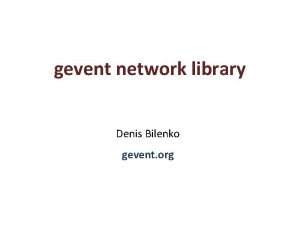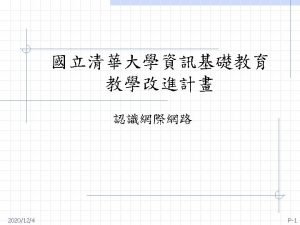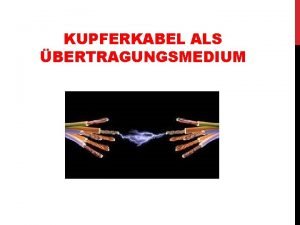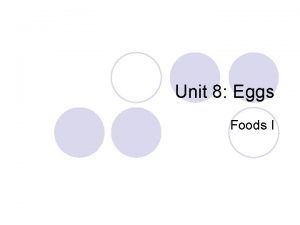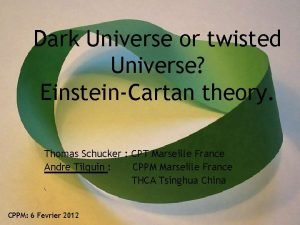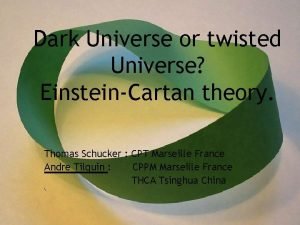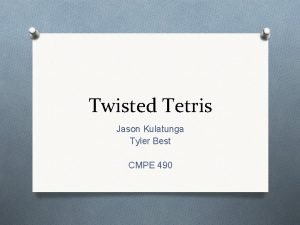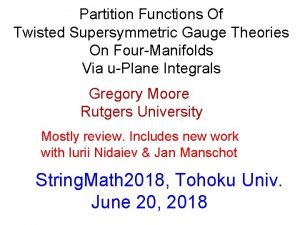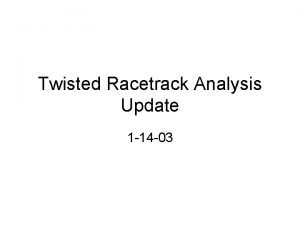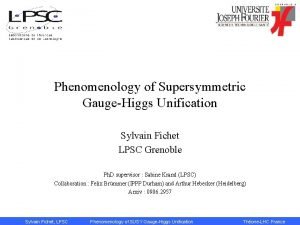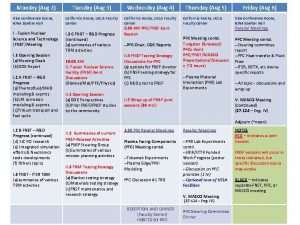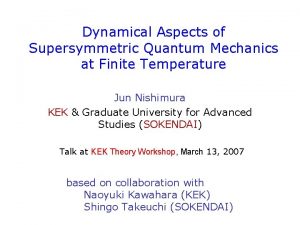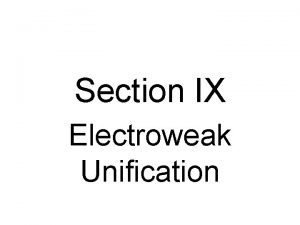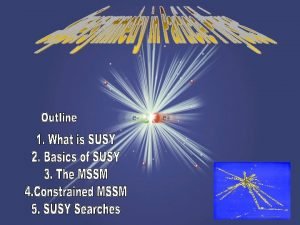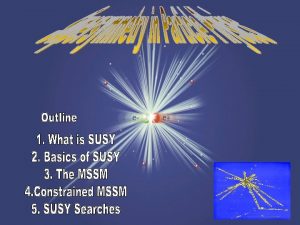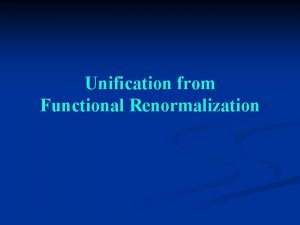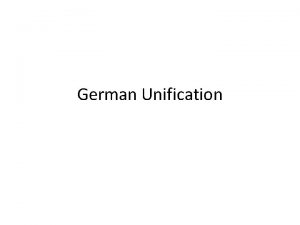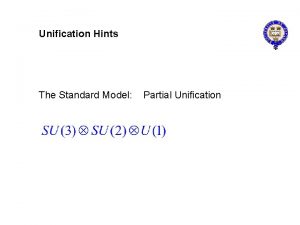Phenomenological aspects of Generation Twisted Supersymmetric Unification Aug































- Slides: 31

Phenomenological aspects of Generation Twisted Supersymmetric Unification Aug. 30, 2006, SI 2006 @ APCTP Kentaro Kojima Department of Physics, Kyushu University Based on Kenzo Inoue, K. K. , Koichi Yoshioka, JHEP 0607032; and in preparation

• SUSY is one of the most promising candidates for Te. V scale new physics – solves hierarchy problem in the SM Higgs potential – naturally includes DM candidates – MSSM predicts gauge coupling unification! Supersymmetric GUT is well motivated • Neutrino gives important information to the SUSY-GUT very heavy RH neutrinos: SU(3)×SU(2)×U(1) singlets This seems to prefer SO(10) or higher GUT theories But GUTs naively have difficulties about flavor structure 2

Several quarks and leptons are unified into a multiplet: e. g. minimal SU(5) GUT Minimal SO(10) GUT Identified to RH ν Several types of Yukawa coupling unification are predicted: SU(5) relation Symmetric Yukawa matrices Diagonalization matrices Good for third generation, Completely false for the others; SU(5) relation must be modified… Same contributions to CKM and MNS; naively conflict with experimental results Asymmetric matrices are useful… GUTs need nontrivial extensions for the flavor sector 3

Contents of the talk • SO(10) unification with generation twisting • Third generation fermion masses and sparticle spectrum • Radiative EWSB and bottom mass prediction • b→sγ and τ→μγ processes • LSP nature and cosmological constraint • Neutralino relic density • Summary 4

SO(10) unification with generation twisting

MSSM+RHν (assuming the seesaw mechanism) Asymmetric Yukawa matrices seem to be suitable for CKM and MNS in GUTs hierarchical SU(5) relaltion same order Highly asymmetric matrices, so-called lopsided forms, [Babu, Barr 95] But naïve SO(10) GUT cannot accommodate to the asymmetry Symmetric contribution to Yukawa matrices How can we realize the lopsided forms in SO(10)? 6

Generation twisting In generally, there are many candidates for SU(5) 5* in SO(10) (or higher as E 6) multiplets: e. g. . Note: Hd (5*H) should be mixed states of 10 H and others 16 i 10 M 10+5*+1 5+5* 1 27 SU(2) rotation in E 6 Naturally embedded into E 6 GUT [Sato, Yanagida (98); Bando, Kugo, Yoshioka (99)] 7

It is generally difficult to see or test the flavor structure of the GUT since MG is very high. But we may probe into the flavor structure of the GUT through SUSY particle spectrum. In the following, we consider the scenario where • Large top Yukawa coupling mainly comes from • Difference between CKM and MNS is the result of twisted 5* Small VCKM Twisted 5* structure Lopsided Yd and Ye Large VMNS 8

Third generation fermion masses and sparticle spectrum

Yukawa structure at the GUT scale Considered Yukawa matrices (up to relatively small entries) • The angle θ parametrizes down-type Higgs mixing tanβ is decreased with Increasing θ • SU(5) relation is modified by b-τmass ratio depends on Xd Includes SU(5) : Contributions to Ye and Yd are different: 1: -1/3 [Georgi-Jarlskog(79)] • Nearly maximal atmospheric mixing angle comes from Ye 10

Fermion masses in the MSSM Depend on SUSY spectrum “Threshold corrections” In large tanβ, Δb can be very large << Induced by SUSY (cf. non-renorm. theorem) [Hall, Rattazzi, Sarid (94); Blazek, Raby, Pokorski (95); Tobe, Wells (03)] • Sign of μ ⇔ Sign of Δb • (PQ sym. limit) (R sym. limit) 11

Inclusion of radiative EWSB μ and B are fixed by the following two equations at MSUSY GUT scale SUSY breaking parameters Solving the MSSM (+RHν) RGE 12

SO(10) motivated boundary conditions for SUSY breaking parameters Now, SO(10) representations of theory are Independent SUSY breaking parameters at the GUT scale: Includes SU(5) mixed Hd 13

Bottom quark mass prediction for different Xd (Xd=1) (Xd=-1/3) green: excluded by b→sγ decay blue: excluded by τ→μγ decay gray: excluded by Higgs mass bound different Xd → different size of Δb→ different sign of μ different sparticle spectrum xd= 1 : μ<0, hierarchical spectrum (M 1/2, |μ|<<m 0) xd=-1/3: μ>0, hierarchy must be weakened 14

LSP nature and cosmological constraint

Suppression of the neutralino relic density In our scenario, LSP is neutralino; Contribution tends to be too large Xd=1 case: Rχ can be small (Suppressed μ is consistent with mb) Suppressed Xd case: Rχ should be nearly 1 (only bino-like LSP is allowed) CP-odd Higgs resonance can suppresses the density 16

• Xd = 1 case • Xd = -1/3 case [Calculated by Dark. SUSY] • Higgsino-like LSP suppresses • CP-odd Higgs resonance also suppresses the density, but where correct mb cannot be achieved. • CP-odd Higgs mass is relatively light and insensitive to m 0 • Suppression of the density is enough supplied by 17

Parameter scan for Xd=1 case: Constraints for bottom mass, b→sγ, superparticle masses are included • Relic density has strong correlation with gaugino fraction • Higgsino components effectively suppress the density • LSP should have negligible higgsino components 18

Parameter scan for Xd=-1/3 case: Constraints for bottom mass, b→sγ, sparticle masses are included • The relic density has strong correlation with CP-odd Higgs mass • LSP mass should be near the half of the CP-odd Higgs mass: • Sizable τ→μγ ratio is expected for relatively light SUSY spectrum; It may be observed near future experimental searches 19

Summary • We study low energy remnants of the generation twisting. • Typical sparticle mass spectrum is changed depending on the breaking degree of SU(5) relation, : heavy scalars, LSP should have higgsino components : relatively light spectrum is allowed; large LFV ratio; masses of LSP and CP-odd Higgs should be correlated • Future searches of SUSY particles and flavor violations may be the probe into flavor sector of the unified theory 20

21

Appendix

Largely broken SU(5) relation • SU(5) relation must be broken to reproduce observed mass pattern of 1 st and 2 nd generation. • In generally the breaking appears in large asymmetrical entries due to group-theoretical factor, non-renorm. o. p. [Georgi, Jarlskog (79); Ellis, Gaillard (79)] • Even if the 3 -3 entries are unified, bottom-tau mass ratio has a large deviation from 1; e. g. 23

Large threshold correction to the bottom mass in large or moderate tanβ regime Δb can be easily large as O(0. 5) for tanβ~ 50 • Sign of μ ⇔ Sign of Δb • (PQ sym. limit) (R sym. limit) 24

Bottom mass prediction without the correction tanβ and θ are correlated Experimental range Input parameters 25

Implications for superparticle spectrum Bottom mass prediction and allowed range of Δb strong correlation; due to the lopsided Yd SU(5) breaking factor xd Various SUSY spectra are expected depends on xd and θ (tanβ) e. g. xd=1 xd=-1/3 μ<0 and relatively hierarchical spectrum are expected for a large value of tanβ μ>0 and scalars cannot be much heavier than gauginos and higgsisnos 26

Radiative EWSB conditions at MSUSY Solving the RGE • positive D-term reduce the size of μ • increasing θ, CP-odd Higgs mass tends to be large 27

b s γ rare decay process When tanβ is not small, three diagrams give important contributions: Consistent with exp. The both must be suppressed or Each of them must be canceled out (allowed only for μ>0; suppresed Xd case) Xd=1 case: Suppressed Xd case: 28

Lepton flavor violating process Large 2 -3 entry of Ye RGE between induces irreducible 2 -3 mixing in the mass matrix for scalar lepton doublet D-term contributions amplify non-degeneracy of the scalar leptons: Non-zero D-term contributions enhances B(τ μγ) For suppressed Xd case, where relatively light scalars are allowed, sizable B(τ μγ) is expected 29

• Xd = 1 case (preliminary) • Higgsino-like LSP suppresses [Calculated by Dark. SUSY] • The s-channel pole also suppresses the density, but where correct mb cannot be achieved. 30

• Xd = -1/3 case • CP-odd Higgs mass is relatively light and insensitive to m 0 • Suppression of the density is enough supplied 31
 The instillation of faith-hope
The instillation of faith-hope Phenomenological theory of personality
Phenomenological theory of personality Initiell
Initiell Ang palimbagan ng el filibusterismo
Ang palimbagan ng el filibusterismo Gon root word
Gon root word Aug q
Aug q Aug methionine start codon
Aug methionine start codon Aug comm device
Aug comm device Amino acids sequence chart
Amino acids sequence chart First gen antipsychotics
First gen antipsychotics Oh lord you are good and your mercy endureth forever
Oh lord you are good and your mercy endureth forever Application of twisted pair cable
Application of twisted pair cable Gambar kabel twisted pair
Gambar kabel twisted pair Twisted tube heat exchanger
Twisted tube heat exchanger G.hn over twisted pair
G.hn over twisted pair Twisted shoulder joint
Twisted shoulder joint The night of the scorpion by nissim ezekiel
The night of the scorpion by nissim ezekiel Genetics a twisted tale
Genetics a twisted tale Twisted ankle
Twisted ankle Define:gevent
Define:gevent Egg white composition
Egg white composition Coaxial cable twisted pair fiber optic
Coaxial cable twisted pair fiber optic Twisted pair kabel vorteile
Twisted pair kabel vorteile Keith sweat twisted mp3
Keith sweat twisted mp3 Preparation of forcemeat
Preparation of forcemeat What is the theme of speak by laurie halse anderson
What is the theme of speak by laurie halse anderson Twisted laurie halse anderson summary
Twisted laurie halse anderson summary 3 bit counter t flip flop
3 bit counter t flip flop Twisted universe
Twisted universe A flag wags like a fishhook there in the sky
A flag wags like a fishhook there in the sky Twisted universe
Twisted universe Jason kulatunga
Jason kulatunga

